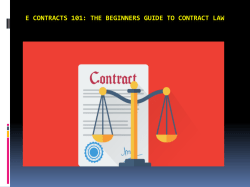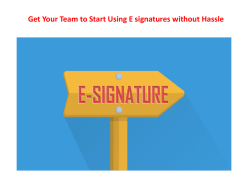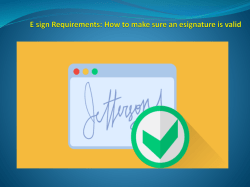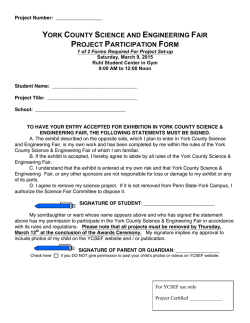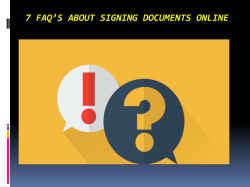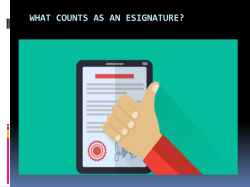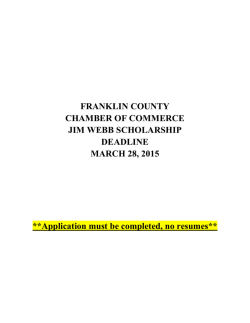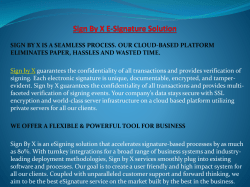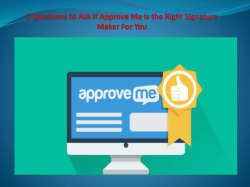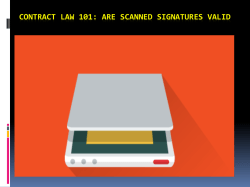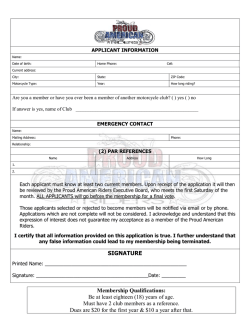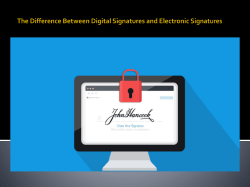
How the ESign Act Makes Esignatures Work
HOW THE ESIGN ACT MAKES ESIGNATURES WORK As we’ve previously covered the difference between electronic signatures and digital signatures, using an esignature to sign agreements, contracts and similar sorts of documents is a great way to save time and money. However, it’s all well and good saying that, but you need to know some of the reasons why an esignature really is an accepted way to sign documents. A signature, as you’ll know is a legal entity. It needs to carry weight in a courtroom so it can be used in any dispute over an agreement. Notarized, hard copy signatures have had this ability since the dawn of writing. However, an electronic version of a signature needs the same sort of legal validation. To give something validity, there has to be some sort of law recognizing it as such. In the U.S. this legal weighting was given recognition in the form of an electronic signatures act called ESIGN. ESIGN stands for Electronic Signatures in Global and National Commerce Act, which was enacted into law in 2000. This law allows electronically signed documents to have the same legal status as hard copy signed documents. The act covers both U.S. interstate and foreign transactions based on an esignature. There must be more to ESIGN than this? There is; a signed electronic document needs more than just a signature to give it that all-important legal weight. Let’s have a look at what a legally binding electronically signed document actually is: The electronic signatures act (ESIGN) sets out exactly what an esignature can comprise of. In the act, it states that an electronic signature: …means an electronic sound, symbol, or process, attached to or logically associated with a contract or other record and executed or adopted by a person with the intent to sign the record. This is pretty broad statement, so as long as the signature type itself is covered we then need to conform to the rest of the requirements of the ESIGN act to make the document legal. The whole point of the electronic signatures act and its respective clauses is to ensure that an electronic signature solution carries out certain basic process requirements that will mean that the signature it has applied to a document will stand up in a court of law. This translates to the following: •Secure Retention of Signed Documents:The act requires that the esignature software is capable of retaining the document in its original form in a secure repository so that all stakeholders have access. The ApproveMe esignature will identify immediately any changes to a document, invalidating the signature and notifying the stakeholders of the change. •Security and authentication. For a signature to hold any muster in court it needs to be proven beyond doubt that it was actually signed by the person it represents. This can be done using authentication at the time of signing. ApproveMe offers a number of different methods to tie the signature to the signer. This includes email access, knowledge-based questions, and receipt of an SMS code. •Consent: The ESIGN act specifies that during a B2C workflow process of a document, provision for the recipient to be able to consent to the electronic process and to have an alternative non-electronic option available if they so wish. However an esignature is still valid in a court of law as long as recipients have access to the electronic documents and have some sort of audit of the signature process and workflow, the electronic signature software is in compliance. ApproveMe offers a full audit trail of document lifecycle workflow and signature events, with timestamps. See section 101/c of the ESIGN act. •Auditability: Continuing from above, the esignature process must be auditable. This means that each part of the lifecycle of the document, from creation to multi-party signature transactions, should be available to all concerned parties. Audits show that each party has knowledge of where the process is at any point. ApproveMe makes a detailed audit trail available from your own online website to all stakeholders involved in the signing of an agreement. There is then no excuse for not knowing where a document is in the process. •Nonrepudiation: Nonrepudiation is really the pillar upon which a digital signature stands. It is used to prove, irrevocably, that a signature is true and cannot be denied. It is usually achieved by using a mix of authentication (mentioned above) and signature- document integrity. The integrity part is achieved using a special type of encryption known as a ‘hash’. The hash is tied to the signature and if anything changes in a document once the signature is applied, the hash will change and will show as an invalid signature. Is there any catch with esignatures? There are products that allow an esignature to be applied to Microsoft Word and PDF for example, but as we’ve seen above, to comply with ESIGN you need to go further than a signature. You need to have a system that makes it easy to take a contract, etc. and pull them into a workflow process built around esigning. Unless you take a holistic approach to electronic signing then you won’t be able to know, for sure, that that contract you’re signing is actually watertight. ApproveMe is an ESIGN complaint product, check out how it can make your workflow processes easy and efficient, letting you get on with your workday. https://www.approveme.com/ Article Resource: https://www.approveme.com/e-signature/how-the-esign-actmakes-esignatures-work/
© Copyright 2026
